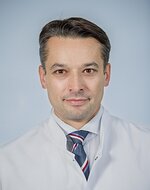The clinic grew out of the private practice run by Prof. Józef Kałużny. It officially opened its doors in April 2008, and there are currently five members of the Kałużny family in the family-owned business. The clinic is headed by Prof. Józef Kałużny, whose two sons also work there as ophthalmic consultants: Dr. Jakub Kałużny is responsible for posterior segment surgery, whilst his wife, Dr. Lucyna Kałużna, deals with dermatological problems. Dr. Bartłomiej Kałużny is head of anterior segment surgery, and his wife, Agnieszka Kałużna, is Managing Director of OFTALMIKA.
Dr. Bartłomiej Kałużny is also Assistant Professor in the Department of Ophthalmology at Nicolaus Copernicus University Collegium Medicum in Bydgoszcz, a post he has held since 2009. He has already published more than 80 academic papers and is a reviewer for peer-reviewed professional journals such as „Ophthalmology“, „Cornea“ and „Optometry and Vision Science“.
The SCHWIND AMARIS 750S has been used at the OFTALMIKA Eye Clinic since June 2011. Its purchase was partially financed by the EU as part of a funding programme for new members of the European Union. The clinic has already performed 1,500 procedures using the SCHWIND laser and the numbers are growing ever faster. Dr. Kałużny estimates that around 450 treatments will be performed in 2015.
Together with his team, comprising another ophthalmologist, two optometrists, two nurses and two administrative staff, Dr. Kałużny is in charge of refractive surgery at OFTALMIKA. The clinic has focused exclusively on surface treatments since its founding. Around 40 percent of these have been performed as TransPRK and the remaining 60 percent as LASEK or alcohol-assisted PRK. TransPRK is used to correct myopia and compound myopic astigmatism with a spherical equivalent of between -1.5 and -9 dioptres. “I use the same optical zone for all surface treatments, regardless of the technique. In higher astigmatism I tend to use an optical zone of at least 7.5 mm whenever possible. In all surface treatments I use 0.02-0.01% mitomycin C.”
The clinic also began offering FemtoLASIK in May 2015. “The safety of the treatment is the decisive aspect for us. For this reason, we only started using the LASIK procedure when we acquired a femtosecond laser for creating the flap,” said Dr. Kałużny.
The clinic’s retreatment rate is extraordinarily low. Dr. Kałużny admits that he can barely believe it himself, but so far they have only had to retreat a single patient. That translates to a rate of 0.15%, which is a clear indication of the quality of the treatments provided. By the way, its strict focus on quality and excellent service is the clinic’s answer to a problematic phenomenon in the Polish market. Coupon sites like Groupon sell a large number of treatments to laser surgery candidates at discount prices. The result is not only a lower price level across the market, but also lower quality of treatment. Luckily, there is also a growing patient segment for whom price is not as important as the quality of the treatment.
Compared with Western Europe, OFTALMIKA’s prices are highly competitive, at between 1,500 and 3,300 złoty (PLN) per eye, depending on the laser technique used, which corresponds to between €364 and €800. A diagnostic examination for both eyes and the first consultation cost 250 złoty (approx. €60). Within its treatment portfolio, the clinic has positioned TransPRK as a premium procedure and patients consequently pay more.
Dr. Kałużny decided on the SCHWIND AMARIS for several reasons: “State-of-the-art technology, SCHWIND’s reputation and the opinion of colleagues. In the end, what helped me reach a final decision was the people who represent SCHWIND. They are there whenever you need them, are responsible and flexible at the same time. That’s a weak point of many other manufacturers and distributors operating in the refractive surgery market. In addition, I place great faith in familyowned companies.”
The clinic’s services are marketed on a website, via social media and by means of academic presentations at congresses alongside other communication channels. “Nevertheless, our expansion is primarily down to word of mouth, i.e. recommendations by ophthalmologist colleagues and satisfied patients,” said Dr. Kałużny. In his opinion, cooperation with responsible and reliable ophthalmologists is particularly important for building up a reputation among colleagues and with patients.
When talking about the AMARIS 750S, the first thing Dr. Kałużny mentions is TransPRK: “One of the laser’s biggest advantages is the TransPRK treatment, which is particularly helpful in patients with irregular corneas. We have not had a single technical problem with the laser in the last four years, but the most convincing argument is by far the excellent results that we achieve time and time again with each individual patient.”




